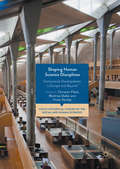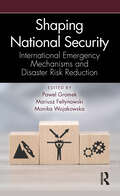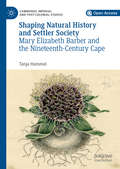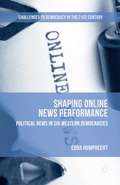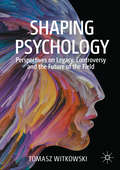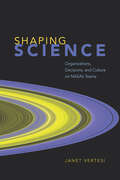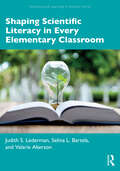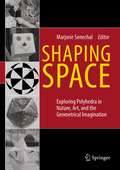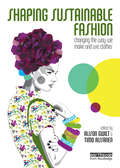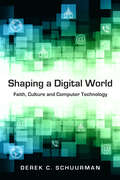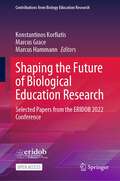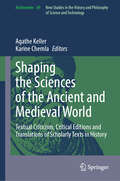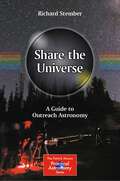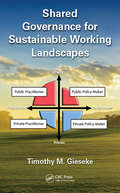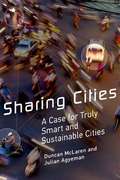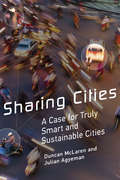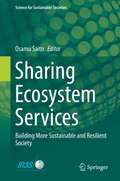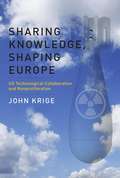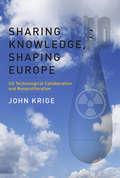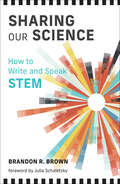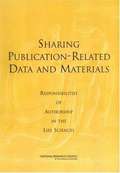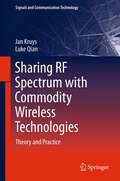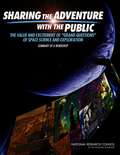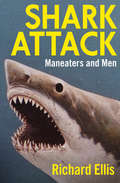- Table View
- List View
Shaping Human Science Disciplines: Institutional Developments in Europe and Beyond (Socio-Historical Studies of the Social and Human Sciences)
by Christian Fleck Matthias Duller Victor KarádyThis book presents an analysis of the institutional development of selected social science and humanities (SSH) disciplines in Argentina, France, Germany, Hungary, Italy, the Netherlands, Sweden and the United Kingdom. Where most narratives of a scholarly past are presented as a succession of ‘ideas,’ research results and theories, this collection highlights the structural shifts in the systems of higher education, as well as institutions of research and innovation (beyond the universities) within which these disciplines have developed. This institutional perspective will facilitate systematic comparisons between developments in various disciplines and countries. Across eight country studies the book reveals remarkably different dynamics of disciplinary growth between countries, as well as important interdisciplinary differences within countries. In addition, instances of institutional contractions and downturns and veritable breaks of continuity under authoritarian political regimes can be observed, which are almost totally absent from narratives of individual disciplinary histories. This important work will provide a valuable resource to scholars of disciplinary history, the history of ideas, the sociology of education and of scientific knowledge.
Shaping National Security: International Emergency Mechanisms and Disaster Risk Reduction
by Pawel Gromek Mariusz Feltynowski Monika WojakowskaShaping National Security: International Emergency Mechanisms and Disaster Risk Reduction presents international emergency mechanisms relative to disaster risk reduction (DRR). The goal is to share knowledge about existing frameworks, and utilize established DRR policies and programs, as another means to reinforce and strengthen national security in countries around the world. The book outlines, in detail, the United Nations Disaster Assessment and Coordination (UNDAC), the International Search and Rescue Advisory Group (INSARAG), the North Atlantic Treaty Organisation (NATO) and the Union Civil Protection Mechanism (UCPM) DRR programs. While these entities’ versions of DRR best practices are largely directed at decreasing the impact of disaster hazards, limiting relevant exposure, local vulnerabilities, increasing capacities to cope with disaster, the authors present these frameworks as potential tools, and effective means, to support national security efforts. This is especially important in disaster circumstances when local, and national emergency resources, may be insufficient to face hazards and multi-hazards, and result in cascading effects to occur as hazard events transpire. Chapters present various resources available to them, through these programs, to encourage authorities from every country to effectively apply the mechanisms—and emergency mechanisms specifically—to offer domestic solutions. Due to these programs proven track records in providing organisational standards, the use of such mechanisms can serve as both the basis to foster sound DRR practices and, by extension, can supplement resiliency, security, and continuity within countries. This concept is based on the premise that the UNDAC, INSARAG, NATO and ECPM emergency mechanisms have been developed to be implementable (directly or indirectly) in every country in the world when disasters occur. Shaping National Security takes a "big-picture," holistic view of DRR and national security to offer innovative ideas and solutions to professionals and officials working in disaster management, disaster risk reduction, emergency management, crisis management, civil protection, public security management, national security, criminal justice, international studies, and homeland security.
Shaping Natural History and Settler Society: Mary Elizabeth Barber and the Nineteenth-Century Cape (Cambridge Imperial and Post-Colonial Studies Series)
by Tanja HammelThis book explores the life and work of Mary Elizabeth Barber, a British-born settler scientist who lived in the Cape during the nineteenth century. It provides a lens into a range of subjects within the history of knowledge and science, gender and social history, postcolonial, critical heritage and archival studies. The book examines the international importance of the life and works of a marginalized scientist, the instrumentalisation of science to settlers' political concerns and reveals the pivotal but largely silenced contribution of indigenous African experts. Including a variety of material, visual and textual sources, this study explores how these artefacts are archived and displayed in museums and critically analyses their content and silences. The book traces Barber’s legacy across three continents in collections and archives, offering insights into the politics of memory and history-making. At the same time, it forges a nuanced argument, incorporating study of the North and South, the history of science and social history, and the past and the present.
Shaping Online News Performance: Political News In Six Western Democracies (Challenges to Democracy in the 21st Century)
by Edda HumprechtThe author offers a comprehensive portrait of online news performance in Western countries in changing media environments. Drawing on a content analysis of 48 news outlets from different types of media organization in France, Germany, Great Britain, Italy, Switzerland, and USA, Edda Humprecht investigates the complex interplay of systemic and organizational dynamics and their impact on online news content, showing that the performance of online news media strongly varies among different media outlets. Less profit oriented outlets and those with a focus on information generally perform well offering hard news, diversity, critical distance, or analytical depth. This suggests that the divide between high and low-performing outlets is tied to the news outlet's capacity and willingness to strike a balance between their profit orientation and their normative role as information providers. Furthermore, the findings demonstrate that different dimensions of news performance are more pronounced in certain countries. This book provides new theoretical perspectives and methods for political and media scholars, and insights for journalists, policymakers, and concerned citizens.
Shaping Psychology: Perspectives on Legacy, Controversy and the Future of the Field
by Tomasz WitkowskiShaping Psychology is a unique collection of in-depth conversations with a selection of the most influential psychologists working today, conducted at the end of a decade that shook psychological science. They provide insights into the controversies at the heart of contemporary psychology, revealing a clash of visions of what psychological science is all about and what its future holds. They are candid on the crisis in psychology and explore its causes, consequences and how to overcome it. They also discuss challenges in the field, their careers, and the experiences that shaped their worldview.Those interviewed include pioneers who have shaped psychology as we know it today and who represent a wide range of specializations, from research to mental health practice, mainstream psychology to critical psychology and neuroscience to the Open Science movement. Elizabeth F. Loftus, Stanford University, USAJerome Kagan, Harvard University, USAMichael I. Posner, University of Oregon, USAScott O. Lilienfeld, Emory University, USARobert J. Sternberg, Cornell University, USARobert Plomin, King’s College London, UK Susan J. Blackmore, University of Plymouth, UKJoseph E. LeDoux, New York University, USANoam Chomsky, Massachusetts Institute of Technology, USARoy F. Baumeister, University of Queensland, AustraliaErica Burman, University of Manchester, UKBrian A. Nosek, University of Virginia, USAVikram H. Patel, Harvard Medical School, USADaniel Kahneman, Princeton University, USACarol A. Tavris, independent academic, USA,
Shaping Science: Organizations, Decisions, and Culture on NASA’s Teams
by Janet VertesiIn Shaping Science, Janet Vertesi draws on a decade of immersive ethnography with NASA’s robotic spacecraft teams to create a comparative account of two great space missions of the early 2000s. Although these missions featured robotic explorers on the frontiers of the solar system bravely investigating new worlds, their commands were issued from millions of miles away by a very human team. By examining the two teams’ formal structures, decision-making techniques, and informal work practices in the day-to-day process of mission planning, Vertesi shows just how deeply entangled a team’s local organizational context is with the knowledge they produce about other worlds. Using extensive, embedded experiences on two NASA spacecraft teams, this is the first book to apply organizational studies of work to the laboratory environment in order to analyze the production of scientific knowledge itself. Engaging and deeply researched, Shaping Science demonstrates the significant influence that the social organization of a scientific team can have on the practices of that team and the results they yield.
Shaping Scientific Literacy in Every Elementary Classroom (Teaching and Learning in Science Series)
by Judith S. Lederman Selina L. Bartels Valarie AkersonThis textbook guides teachers in enacting science instruction that results in the cultivation of scientifically literate students in elementary school. Prompting discussions in the pre-service environment around what it means to be scientifically literate, this book helps teachers introduce children to their world through science and its impact on their daily lives. Chapters show teachers how to design, implement, and assess inquiry-based science instruction through lessons that authentically model real science, investigating questions with multiple solutions, and discussing how these lessons build students’ scientific literacy. Sample lessons are modeled on research and tested practice while also recognizing the need to accommodate a diverse range of students and classroom contexts. Ideal for pre-service science teachers, as well as in-service professional development, this book can be used in any elementary science methods course or wherever state or national standards require developing scientific literacy. In helping teachers produce scientifically literate students, it is a resource that enables students to have the content knowledge, attitudes, and abilities to see the role science plays in issues from the personal to the global.
Shaping Space
by Marjorie SenechalThis second edition is based off of the very popular Shaping Space: A Polyhedral Approach, first published twenty years ago. The book is expanded and updated to include new developments, including the revolutions in visualization and model-making that the computer has wrought. Shaping Space is an exuberant, richly-illustrated, interdisciplinary guide to three-dimensional forms, focusing on the suprisingly diverse world of polyhedra. Geometry comes alive in Shaping Space, as a remarkable range of geometric ideas is explored and its centrality in our cultre is persuasively demonstrated. The book is addressed to designers, artists, architects, engineers, chemists, computer scientists, mathematicians, bioscientists, crystallographers, earth scientists, and teachers at all levels--in short, to all scholars and educators interested in, and working with, two- and three-dimensinal structures and patterns.
Shaping Sustainable Fashion: Changing the Way We Make and Use Clothes
by Alison Gwilt Timo RissanenThe production, use and eventual disposal of most clothing is environmentally damaging, and many fashion and textile designers are becoming keen to employ more sustainable strategies in their work. This book provides a practical guide to the ways in which designers are creating fashion with less waste and greater durability. Based on the results of extensive research into lifecycle approaches to sustainable fashion, the book is divided into four sections: source: explores the motivations for the selection of materials for fashion garments and suggests that garments can be made from materials that also assist in the management of textile waste make: discusses the differing approaches to the design and manufacture of sustainable fashion garments that can also provide the opportunity for waste control and minimization use: explores schemes that encourage the consumer to engage in slow fashion consumption last: examines alternative solutions to the predictable fate of most garments – landfill. Illustrated throughout with case studies of best practice from international designers and fashion labels and written in a practical, accessible style, this is a must-have guide for fashion and textile designers and students in their areas.
Shaping a Digital World: Faith, Culture and Computer Technology
by Derek C. SchuurmanDigital technology has become a ubiquitous feature of modern life. Our increasingly fast-paced world seems more and more remote from the world narrated in Scripture. But despite its pervasiveness, there remains a dearth of theological reflection about computer technology and what it means to live as a faithful Christian in a digitally-saturated society. In this thoughtful and timely book, Derek Schuurman provides a brief theology of technology, rooted in the Reformed tradition and oriented around the grand themes of creation, fall, redemption and new creation. He combines a concise, accessible style with penetrating cultural and theological analysis. Building on the work of Jacques Ellul, Marshall McLuhan and Neil Postman, and drawing from a wide range of Reformed thinkers, Schuurman situates computer technology within the big picture of the biblical story. Technology is not neutral, but neither is there an exclusively "Christian" form of technological production and use. Instead, Schuurman guides us to see the digital world as part of God?s good creation, fallen yet redeemable according to the law of God. Responsibly used, technology can become an integral part of God?s shalom for the earth.
Shaping the Future of Biological Education Research: Selected Papers from the ERIDOB 2022 Conference (Contributions from Biology Education Research)
by Marcus Hammann Marcus Grace Konstantinos KorfiatisThis open access volume is a collection of full papers based on the peer-reviewed presentations accepted for the European Researchers in Didactics of Biology, ERIDOB 2022 conference. ERIDOB aims to bring together researchers in didactics of Biology from Europe and around the world to share and discuss their research work and results. It is the only major international conference whose focus lies exclusively on biology education research, and all the papers are written by international researchers from across Europe (and beyond) which report on a range of contemporary biology education research projects. They are all entirely new papers describing new research in the field. Each paper has been peer-reviewed by experienced biology education researchers and the members of the ERIDOB Academic Committee. The selected papers are collated within the following categories of biology education: · Teaching Strategies and Learning Environments · Students’ Knowledge, Conceptions, Values, Attitudes and Motivation · Outdoor and Environmental Education · Biology Teachers’ Professional Development By providing a collection of new research findings from many countries, this book is a great resource for researchers and practitioners such as school, college and university biology teachers' around the world. It is useful for training biology teachers and therefore valuable to teacher training institutions.
Shaping the Sciences of the Ancient and Medieval World: Textual Criticism, Critical Editions and Translations of Scholarly Texts in History (Archimedes #69)
by Karine Chemla Agathe KellerThis book contributes to a worldwide history of textual criticism and critical editions of ancient scientific texts. It first looks at ancient editorial practices, and at their impact on modern editions. Contributions analyze how, through time, the perception of what a text was may have changed, and influenced how scholarly texts were made accessible. The second section looks at the historical, political and social contexts within which editions and translations of ancient scientific texts were produced. Finally, the last two parts examine the specificities of editions and translations that bore on scholarly documents. Not only is there a focus on how the elements specific to scientific texts—such as diagrams and numbers—were treated, but case studies analyzing the specific work carried out to edit mathematical and astronomical texts of the past are also offered to the reader. The scholarship displayed in this work lays the foundation for further studies on the history of critical editions and raises questions to those who make scholarly translations and critical editions today.
Share the Universe: A Guide to Outreach Astronomy (The Patrick Moore Practical Astronomy Series)
by Richard StemberAs every astronomer knows, astronomy is one of the most approachable and inspiring of the natural sciences. It appeals to both children and adults while drawing in curious minds with its immense distances and unimaginably powerful natural phenomena. In this book, you will find out how to be a part of the journey in sharing scientific knowledge and inspiring minds of all ages. By using the affordable tools and techniques provided in this book – you will learn about how astronomers can easily engage people with views of our solar system’s planets, moons, and even more distant objects like nebulas, stellar nurseries, and remnants of exploded stars. Perhaps most importantly, the natural appeal of this science is helpful when explaining to non-scientists how science “works." What is science and scientific methodology? How is it used to give mankind knowledge and solutions to problems that we face in many scientific fields including medicine? How does it differ from other sources of information? This book, sprinkled with the author’s 24 plus years of personal experience in public outreach, offers practical techniques to engage, educate, and inspire all who are interested in the field of astronomy.
Shared Borders, Shared Waters: Israeli-Palestinian and Colorado River Basin Water Challenges
by Sharon B. Megdal Robert G. Varady Susanna EdenThis collection of papers examines water management in two of the worlds prominent, arid transboundary areas facing similar challenges. In the Middle East, the chronically water-short Israeli-Palestinian region has recognized the need both to conserve and supplement its traditional water sources. Across the globe on the North American continent, A
Shared Governance for Sustainable Working Landscapes
by Timothy M. GiesekeSustaining our agricultural landscapes is no longer just a technical, scientific or even political problem, but it has evolved into a socially complex, so-called wicked problem of conflicting social governance and economics. This creates an extreme economic obstacle where the value of ecosystem services remains low and diffuse and the transactions costs remain high and multiple.Using Uber-like business platform technology and a shared governance model, a symbiotic demand for environmental benefits is created. Enabling multi-sector transactions for environmental benefits, this platform innovation would remedy the "tragedy of the commons"; the economic nemesis to achieving landscape sustainability. In a nutshell, to sustain our agricultural landscapes a transdisciplinary approach supported by a shared governance model housed within a multi-sided platform in needed. This book introduces an assessment framework identifying governance actors, styles and ratios for socio-ecological systems. The assessment uses a new governance compass to identify the types of actors completing which tasks and identifies the styles of governance used to complete the tasks. It is aimed to anyone involved in sustainability science, agricultural policy planning, or integrated landscape design.
Sharing Cities: A Case for Truly Smart and Sustainable Cities
by Julian Agyeman Duncan MclarenThe future of humanity is urban, and the nature of urban space enables, and necessitates, sharing -- of resources, goods and services, experiences. Yet traditional forms of sharing have been undermined in modern cities by social fragmentation and commercialization of the public realm. In Sharing Cities, Duncan McLaren and Julian Agyeman argue that the intersection of cities' highly networked physical space with new digital technologies and new mediated forms of sharing offers cities the opportunity to connect smart technology to justice, solidarity, and sustainability. McLaren and Agyeman explore the opportunities and risks for sustainability, solidarity, and justice in the changing nature of sharing. McLaren and Agyeman propose a new "sharing paradigm," which goes beyond the faddish "sharing economy" -- seen in such ventures as Uber and TaskRabbit -- to envision models of sharing that are not always commercial but also communal, encouraging trust and collaboration. Detailed case studies of San Francisco, Seoul, Copenhagen, Medellín, Amsterdam, and Bengaluru (formerly Bangalore) contextualize the authors' discussions of collaborative consumption and production; the shared public realm, both physical and virtual; the design of sharing to enhance equity and justice; and the prospects for scaling up the sharing paradigm though city governance. They show how sharing could shift values and norms, enable civic engagement and political activism, and rebuild a shared urban commons. Their case for sharing and solidarity offers a powerful alternative for urban futures to conventional "race-to-the-bottom" narratives of competition, enclosure, and division.
Sharing Cities: A Case for Truly Smart and Sustainable Cities (Urban and Industrial Environments)
by Julian Agyeman Duncan McLarenHow cities can build on the “sharing economy” and smart technology to deliver a “sharing paradigm” that supports justice, solidarity, and sustainability.The future of humanity is urban, and the nature of urban space enables, and necessitates, sharing—of resources, goods and services, experiences. Yet traditional forms of sharing have been undermined in modern cities by social fragmentation and commercialization of the public realm. In Sharing Cities, Duncan McLaren and Julian Agyeman argue that the intersection of cities' highly networked physical space with new digital technologies and new mediated forms of sharing offers cities the opportunity to connect smart technology to justice, solidarity, and sustainability. McLaren and Agyeman explore the opportunities and risks for sustainability, solidarity, and justice in the changing nature of sharing. McLaren and Agyeman propose a new “sharing paradigm,” which goes beyond the faddish “sharing economy”—seen in such ventures as Uber and TaskRabbit—to envision models of sharing that are not always commercial but also communal, encouraging trust and collaboration. Detailed case studies of San Francisco, Seoul, Copenhagen, Medellín, Amsterdam, and Bengaluru (formerly Bangalore) contextualize the authors' discussions of collaborative consumption and production; the shared public realm, both physical and virtual; the design of sharing to enhance equity and justice; and the prospects for scaling up the sharing paradigm though city governance. They show how sharing could shift values and norms, enable civic engagement and political activism, and rebuild a shared urban commons. Their case for sharing and solidarity offers a powerful alternative for urban futures to conventional “race-to-the-bottom” narratives of competition, enclosure, and division.
Sharing Ecosystem Services: Building More Sustainable and Resilient Society (Science for Sustainable Societies)
by Osamu SaitoUsing “the sharing paradigm” as a guiding concept, this book demonstrates that “sharing” has much greater potential to make rural society resilient, sustainable and inclusive through enriching all four sharing dimensions: informal, mediated, communal and commercial sharing. The chapters are divided into two parts, one that focuses on case studies of the sharing ecosystem services in Japan, the other on case studies from around the world including in the regions of Africa, Asia-Pacific, South America and Europe. Reflecting the recent growing attention to sharing concept and its application to economic and urban context, this publication explores opportunities and challenges to build more resilient and sustainable society in harmony with nature by critical examination of sharing practices in rural landscapes and seascapes around the world. This book introduces not only traditional communal and non-market sharing practices in different rural areas, but also new forms of sharing through integration of traditional practices and modern science and technologies.
Sharing Knowledge, Shaping Europe: US Technological Collaboration and Nonproliferation
by John KrigeIn the 1950s and the 1960s, U.S. administrations were determined to prevent Western European countries from developing independent national nuclear weapons programs. To do so, the United States attempted to use its technological pre-eminence as a tool of "soft power" to steer Western European technological choices toward the peaceful uses of the atom and of space, encouraging options that fostered collaboration, promoted nonproliferation, and defused challenges to U.S. technological superiority. In Sharing Knowledge, Shaping Europe, John Krige describes these efforts and the varying degrees of success they achieved. Krige explains that the pursuit of scientific and technological leadership, galvanized by America's Cold War competition with the Soviet Union, was also used for techno-political collaboration with major allies. He examines a series of multinational arrangements involving shared technological platforms and aimed at curbing nuclear proliferation, and he describes the roles of the Department of State, the Atomic Energy Commission, and NASA. To their dismay, these agencies discovered that the use of technology as an instrument of soft power was seriously circumscribed, by internal divisions within successive administrations and by external opposition from European countries. It was successful, Krige argues, only when technological leadership was embedded in a web of supportive "harder" power structures.
Sharing Knowledge, Shaping Europe: US Technological Collaboration and Nonproliferation (Transformations: Studies in the History of Science and Technology)
by John KrigeHow America used its technological leadership in the 1950s and the 1960s to foster European collaboration and curb nuclear proliferation, with varying degrees of success.In the 1950s and the 1960s, U.S. administrations were determined to prevent Western European countries from developing independent national nuclear weapons programs. To do so, the United States attempted to use its technological pre-eminence as a tool of “soft power” to steer Western European technological choices toward the peaceful uses of the atom and of space, encouraging options that fostered collaboration, promoted nonproliferation, and defused challenges to U.S. technological superiority. In Sharing Knowledge, Shaping Europe, John Krige describes these efforts and the varying degrees of success they achieved. Krige explains that the pursuit of scientific and technological leadership, galvanized by America's Cold War competition with the Soviet Union, was also used for techno-political collaboration with major allies. He examines a series of multinational arrangements involving shared technological platforms and aimed at curbing nuclear proliferation, and he describes the roles of the Department of State, the Atomic Energy Commission, and NASA. To their dismay, these agencies discovered that the use of technology as an instrument of soft power was seriously circumscribed, by internal divisions within successive administrations and by external opposition from European countries. It was successful, Krige argues, only when technological leadership was embedded in a web of supportive “harder” power structures.
Sharing Our Science: How to Write and Speak STEM
by Brandon R. BrownA personal, practical, and inspirational guide to written and oral STEM communications for scientists and technical professionals.In Sharing Our Science, scientist-turned-writing teacher Brandon Brown offers an eminently useful guidebook for STEM practitioners looking to communicate their technical work to either a technical or a broader audience. Professionals are increasingly required to communicate their work through blogs, podcasts, and newsletters and to submit to traditional media. After seeing his colleagues struggle to find a writing guide that tackled the unique challenges of writing and speaking about scientific topics, Brown set out to write the definitive handbook to assist STEM students, scientists, engineers, and tech workers alike.In this practical and relevant book, Brown uses his experience as a proven science communicator to cover three levels of writing: fundamental craft considerations, such as narrative tension, structure, sentences, and audience; unique scientific considerations, such as conveying numbers and utilizing metaphors; and finally, social considerations, such as public speaking and writing inside and outside of silos. In place of a reference manual, Brown&’s engaging narrative guide clarifies the fundamental principles that impact all scientific communication tasks, from white papers and slide decks to Zoom meetings and emails. Sharing Our Science represents the culmination of a lifetime of writing, research, and teaching that will enrich scientists&’ careers and illuminate the ways in which science is done and conveyed to the world.
Sharing Publication-related Data And Materials: Responsibilities Of Authorship In The Life Sciences
by Committee on Responsibilities of Authorship in the Biological SciencesBiologists communicate to the research community and document their scientific accomplishments by publishing in scholarly journals. This report explores the responsibilities of authors to share data, software, and materials related to their publications. In addition to describing the principles that support community standards for sharing different kinds of data and materials, the report makes recommendations for ways to facilitate sharing in the future.
Sharing RF Spectrum with Commodity Wireless Technologies
by Jan Kruys Luke QianMuch energy has been spent on the subject of spectrum scarcity that would threaten to stunt the growth of wireless technologies and services. This concern comes on the heels of the great successes of both cellular communications and consumer oriented communications like Wi-Fi and Bluetooth that have changed the way people use computers and communications and that have led to the creation of large new markets for products and services. The response of many spectrum regulators throughout the world in addressing these concerns has been to consider releasing more spectrum for unlicensed or for shared use. An example is the spectrum that is released by the transition to digital TV: the frequencies freed up are destined, in part, to new applications that would be license exempt. A possible beneficiary of new spectrum releases would be "the smart grid", a networked application of digital sensor and control technology to the energy delivery segment of the energy utility industry. This policy has heightened the interests of all involved in spectrum sharing and many proposals are being considered or brought forward. However, theory in this area is scarce and practice proves resistive of quick solutions. A case in point is RLAN/radar spectrum sharing in the 5GHz range: six years after the ITU-R allocated this shared spectrum, the rules for sharing as well as the means to verify compliance with these rules are not fully mature. Another recent development is the interest in spectrum pricing and trading which tend to focus on the economic aspects of spectrum sharing at the expense understanding of the limitations as well as the technical possibilities of spectrum sharing.
Sharing The Adventure With The Public
by The National Academy of SciencesOn November 8-10, 2010, the National Research Council's Space Studies Board (SSB) held a public workshop on how NASA and its associated science and exploration communities communicate with the public about major NASA activities and programs. The concept and planning of the workshop developed over a period of two years. In conjunction with the SSB, the workshop planning committee identified five "Grand Questions" in space science and exploration around which the event was organized. As outlined in the summary, the workshop concluded with sessions on communicating space research and exploration to the public.
Shark Attack
by Richard EllisRenowned marine conservationist and artist Richard Ellis addresses the popular myths, misconceptions, and exploits of great white sharks, tiger sharks, bull sharks, and the many other species that roam the waters of our planetDo sharks deserve their universally bad reputation? Sharks are clearly not harmless--Shark Attack includes many true stories of seemingly unwarranted attacks on humans. Yet if sharks truly were vengeful carnivores, no beach on earth would be safe for fishing, surfing, or swimming. Ellis argues that Jaws, the popular 1975 film that misrepresented sharks in almost every detail, has damaged our perception of sharks. Today, museums and aquariums endeavor to rehabilitate the shark's image, and environmentalists and animal rights activists struggle to slow relentless overfishing. Yet their efforts may be too late to save hundreds of shark species from near or total extinction.
